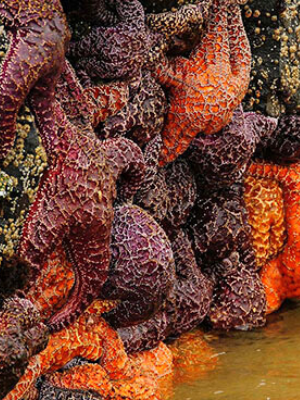
About
Ochre sea stars play a very important role in the rocky intertidal zone. In fact, research done on the ochre sea star is what resulted in the concept of a keystone species – a type of species that plays a defining role in its biological community. In the case of ochre sea stars, their predation upon mussels allows for much greater biodiversity in the rocky intertidal environment. Without sea stars present to hunt, mussels will take over and monopolize the rocky intertidal zone, leaving little room for the many other diverse and colorful residents of the tide pool community!
Why do they need our help?
Ochre sea stars were once an abundant part of Oregon’s rocky intertidal zone. Their bright orange, red, and purple bodies are still a favorite sight for tide pool visitors, but their numbers have been greatly reduced by sea star wasting syndrome. The plague of sea star wasting syndrome that started in 2013 has been deemed the largest observed die-off of marine animals in recorded history.
Research is currently underway to better understand the causes of sea star wasting syndrome. It is believed that rising water temperatures may play a role. Continued research and monitoring is important for the conservation of ochre sea stars.
- Want regular news on our efforts to protect Oregon's imperiled wildlife, and what you can do to help? Sign up for our monthly Wolves and Wildlife Newsletter!
Did you know?
-
Sea stars have the ability to regenerate their limbs! In some cases, a sea star can grow an entire new body from just one lone arm!
-
Ochre sea stars use their suction tube feet to pry open mussel shells. Once they create a tiny opening, less than a millimeter wide, they are able to insert their stomach into the shell and consume the soft flesh of the mussel.

